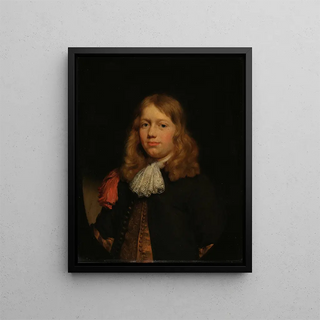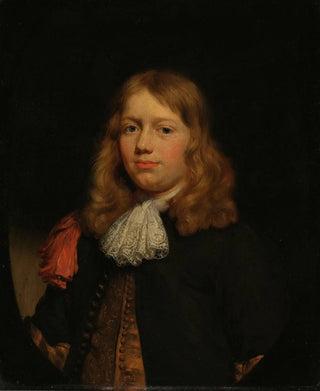Art print | Portrait of a Young Man - Nicolaes Maes


View from behind

Frame (optional)
Portrait of a Young Man - Nicolaes Maes – Captivating Introduction
In the vast panorama of art history, certain works stand out for their ability to capture the very essence of humanity. The "Portrait of a Young Man" by Nicolaes Maes, painted in the 17th century, embodies this quest for truth and beauty. This painting, full of finesse and delicacy, immerses the viewer in an intimate atmosphere where every detail seems to whisper a story. The penetrating gaze of the young man, combined with the subtlety of the colors, invites deep contemplation. Through this art print, the work continues to evoke emotions, bearing witness to the creative genius of its artist.
Style and uniqueness of the work
The uniqueness of the "Portrait of a Young Man" lies in Maes's technical mastery, who manages to harmonize realism and idealization. The soft light, typical of the Dutch Golden Age works, sculpts the young man's face, revealing delicate features and an expression full of meaning. The interplay of shadow and light creates striking depth, while the color palette, subtle and nuanced, gives the entire piece an atmosphere that is both serene and mysterious. Every brushstroke seems to be a caress, making the viewer an accomplice in this fleeting encounter with the subject. This portrait transcends the simple exercise of representation to become a true psychological study, where the soul of the young man unfolds with each gaze.
The artist and his influence
Nicolaes Maes, a pupil of Rembrandt, established himself in the art world thanks to his ability to combine tradition and innovation. His artistic journey is marked by a stylistic evolution that testifies to his talent and adaptability. While his early works were heavily influenced by his master, he gradually developed a personal style, characterized by an increased sensitivity to emotional nuances. Maes was able to capture the spirit of his time, while leaving an indelible mark on his contemporaries and future generations. His approach to portraiture, which emphasizes intimacy and psychology, paved the way for many artists, making him an essential figure of the 17th century. Through his works, he was able to immortalize moments of

Matte finish

View from behind

Frame (optional)
Portrait of a Young Man - Nicolaes Maes – Captivating Introduction
In the vast panorama of art history, certain works stand out for their ability to capture the very essence of humanity. The "Portrait of a Young Man" by Nicolaes Maes, painted in the 17th century, embodies this quest for truth and beauty. This painting, full of finesse and delicacy, immerses the viewer in an intimate atmosphere where every detail seems to whisper a story. The penetrating gaze of the young man, combined with the subtlety of the colors, invites deep contemplation. Through this art print, the work continues to evoke emotions, bearing witness to the creative genius of its artist.
Style and uniqueness of the work
The uniqueness of the "Portrait of a Young Man" lies in Maes's technical mastery, who manages to harmonize realism and idealization. The soft light, typical of the Dutch Golden Age works, sculpts the young man's face, revealing delicate features and an expression full of meaning. The interplay of shadow and light creates striking depth, while the color palette, subtle and nuanced, gives the entire piece an atmosphere that is both serene and mysterious. Every brushstroke seems to be a caress, making the viewer an accomplice in this fleeting encounter with the subject. This portrait transcends the simple exercise of representation to become a true psychological study, where the soul of the young man unfolds with each gaze.
The artist and his influence
Nicolaes Maes, a pupil of Rembrandt, established himself in the art world thanks to his ability to combine tradition and innovation. His artistic journey is marked by a stylistic evolution that testifies to his talent and adaptability. While his early works were heavily influenced by his master, he gradually developed a personal style, characterized by an increased sensitivity to emotional nuances. Maes was able to capture the spirit of his time, while leaving an indelible mark on his contemporaries and future generations. His approach to portraiture, which emphasizes intimacy and psychology, paved the way for many artists, making him an essential figure of the 17th century. Through his works, he was able to immortalize moments of






